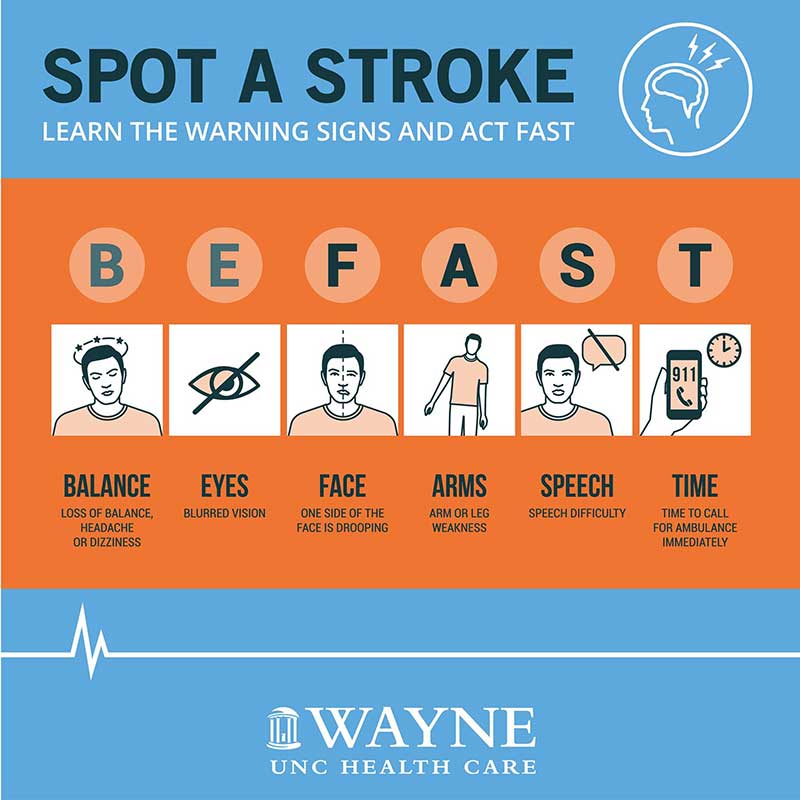Fast Response from Wayne UNC Stroke Team Saves Life of 77-Year-Old Patient
When a stroke paralyzed the entire right side of 77-year-old Hosiea Hewitt’s body, a rapid response from the team at Wayne UNC Health Care helped save his life.
“They acted very fast and got him stabilized,” said Hewitt’s wife Sandra. “As a result, he’s made a good recovery.”
A Rare Case
While our team at Wayne UNC Health Care is capable of providing expert care to a majority of stroke patients, Hewitt presented a rare case that qualified for an intervention the team knew would improve his long-term recovery.
Due to the size and proximity of the clot that caused his stroke, a neurosurgeon based in a comprehensive stroke center could remove the clot in its entirety, according to Stroke Coordinator Sara Ginn, MSN, RN.
Clot Busting Medication
When Hewitt arrived to the Wayne UNC Emergency Department by ambulance, the Wayne UNC team administered the clot-buster Tissue Plasminogen Activator (tPA) within a half hour of onset of symptoms. Administered intravenously, tPA dissolves blood clots, improving and sometimes resolving stroke symptoms.
“Our goal, based on evidence-based standards, is to administer tPa within an hour of their arrival,” said Ginn. “The sooner patients can get it, the better their outcomes often are three months out and long term. They often have fewer deficits.”
In Hewitt’s case, not only were his nurses and Emergency Medicine Dr. Kirk Jones able to administer tPa quickly. They were also able to assess his candidacy for the endovascular intervention within a timeframe that maximized its benefit.
In the weeks following his intervention, Hewitt also received outpatient speech, physical and occupational therapy at Wayne UNC to help him continue in his recovery.
“He had one on one with the therapist, who gave him problems to do, like adding, subtracting and comprehension,” said Sandra.
During Hewitt’s short stay at Wayne UNC, Sandra commented that she appreciated the team who worked with her husband and Ginn, who took time to answer her questions and discuss options for her husband’s care. Ginn also visited Hewitt later in outpatient therapy.
Hewitt describes the care he received at Wayne UNC during and following his stroke as “excellent” and continues to choose our team for his ongoing care.
Continued Gains
Two years after his stroke, Hewitt continues to make gains in his health, though he says that he is still not 100% recovered. “My right side still gives me problems,” he said. Hewitt said he still drags his foot when he walks and has a difficult time holding items with his hands.
“He does exercises around the house, but he does get tired out fast,” said Sandra. “But, he can walk, talk and do his thing. We’re thankful.”
Recognizing the Signs of Stroke
Ginn said to receive the best possible outcome following stroke, it’s important for patients, like Hewitt, to go to the nearest hospital as soon as possible. According to the American Stroke Association, acting F.A.S.T. is key in helping stroke patients get the treatments they need as quickly as possible.
The simple test includes:
F—Face: Ask the person to smile. Does one side of the face droop?
A—Arms: Ask the person to raise both arms. Does one arm drift downward?
S—Speech: Ask the person to repeat a simple phrase. Is the speech slurred or strange?
T—If you see any of these signs, call 9-1-1 right away and, note the time when symptoms first appeared.
Always call an ambulance instead of driving to the hospital or having someone else drive you. Medical personnel can begin life-saving treatment on the way to the emergency room.
